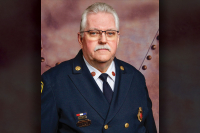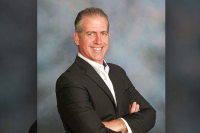Learn how to prepare for backcountry emergencies
Cullowhee-based Landmark Learning is now enrolling for a variety of wilderness medicine certification courses planned for the winter months.
A growing mark: Outdoor school opens world’s largest wilderness medicine classroom in Cullowhee
Just north of Cullowhee, at the curvy, gravel terminus of Cane Creek Road, sits the building containing the world’s largest wilderness medicine classroom.
Landmark Learning, a nationally accredited school offering a variety of courses in wilderness medicine, started using the building in May, though there’s still heavy equipment in view as fine-tuning continues. The 8,000-square-foot building contains a 2,400-square-foot classroom, a commercial kitchen, and a student lounge. Up an even steeper hill than the one that leads to the main building is a pair of dorm-style cabins and a terraced camping area, which together can accommodate 36 people.
Climbing to the top: Local school a hub for outdoor training
 It’s a chilly day on the Tuckasegee River. Air temperature is in the mid-40s, and the water isn’t much warmer.
It’s a chilly day on the Tuckasegee River. Air temperature is in the mid-40s, and the water isn’t much warmer.
Eric Johnson struggles to stand upright, bracing his paddle on the river bottom as a chain of four fellow college students leans on him to traverse the Dillsboro Drop rapid.
Cullowhee school grows beyond expectations
Landmark Learning based in Jackson County offers 80 courses a year providing wilderness medical training to 2,000 people across all sectors of the outdoor and medical industry.
Many of the courses are held at their campus in Cullowhee and around Western North Carolina, but they also regularly offer training at sites around the Southeast.
Justin Padgett and his wife, Maurie, launched the wilderness instruction company in the late 1990s as a side venture while they were both in grad school.
“When we stared Landmark, she thought it was a hobby,” Padgett said.
Now they have a sprawling outdoor campus, five full-time employees and a contract pool of 35 instructors.
“We even made an agreement when we started that we were only going to grow to where we had 10 people outside of us. We now have 40 people including us,” Padgett said. “We never wanted to pay insurance to anybody or get real like that, but we’re doing that.”
It takes one entire staff person just to be in charge of gear. They make sure all the equipment is clean and functioning before heading out into the field, and that the right gear gets to the right place at the right time for each course. The program coordinator does everything from scheduling venues for the courses to purchasing plane tickets for the instructors.
Landmark prides itself on the expertise of its instructors.
“Folks teaching wilderness medicine with us are active in the rescue community. They work for fire departments, they work for EMS, or they work in hospital settings. Some of our staff are surgical assistants,” Padgett said. “Our instructors are professionals and dedicated to doing this. This is their living.”
Padgett is a senior paramedic and ambulance driver for WestCare hospital in addition to his work with Landmark.
Landmark is affiliated with NOLS, the National Outdoor Leadership School. It is the largest NOLS affiliate nationally and the only affiliate in the Eastern U.S. Those who graduate from Landmark have certification bearing the name of NOLS Wilderness Medical Institute.
Landmark has a host of other affiliations and credentials as well.
• N.C. Office of Emergency Medical Services for EMT courses.
• American Canoe Association for swift water rescue and courses for whitewater instructors.
• American Heart Association for First Aid and CPR courses.
• Starfish Aquatics Institute for Lifeguard and Wilderness Lifeguard courses.
• American Mountain Guides Association for Climbing Instructor courses.
www.landmarklearning.org or 828.293.5384.
Learning to treat injuries in the wild
What can you do with a foam pad, rain pants, sleeping bag and an old T-shirt?
A whole lot apparently, according to students who have been through wilderness medical training with Landmark Learning.
Broken leg? No problem. Dislocated shoulder? Gotcha covered. If you get hurt in the backcountry, just keep your fingers crossed one of these guys will find you.
“We teach a lot of improvisation,” said Rob Barham, one of Landmark’s regular instructors.
During a recent course, Barham walked students through the finer points of fashioning a full-leg cast on the fly to stabilize a torn ACL.
“This is mimicking a commercial knee splint with materials you would typically have in your backpack,” said Barham, 34, who lives in Jackson County.
Landmark, based in Cullowhee, offers dozens of outdoor rescue and wilderness medical training courses every year. The most advanced course is a Wilderness EMT, a four-week course that equips students to do everything from drive an ambulance in an urban setting to treat major medical emergencies far from civilization.
A recent wilderness EMT course conducted by Landmark attracted people from across the country and from all walks of the outdoor industry: camp counselors, outfitters, park rangers, you name it.
“We have a lot of injuries in the backcountry, and rangers are the first person to come up on them,” said Kathleen Fleet, 23, a park ranger at Carlsbad Caverns who came for the training.
Two students claiming the longest distance traveled dropped in from Antarctica. They are usually stationed on a ship funded by the National Science Foundation, which hosts rotating research teams every few months off the Antarctic coast. Medical training in such remote surrounds seemed like a wise undertaking.
The course also attracted college students studying to be doctors and nurses — including some already in the profession.
Robin Pope, a physician’s assistant with Sylva Orthopedic Associates, obviously had the basic medical knowledge of the EMT training under his belt already. So he joined the class for only the final week, when instruction shifts to the wilderness module.
Pope is the scout master of his son’s troop and wanted to adjust his thinking to treating emergencies on camping trips versus a clinical setting.
“When a patient comes into the office, it’s a controlled setting, the light is good, the temperature isn’t freezing,” Pope said.
But outdoors, it’s an entirely different ballgame with factors out of your control.
“What do you do with six or seven other kids sitting around looking at you going ‘What are you going to do about this?’” Pope said. “It’s just kind of a different way of thinking.”
Sometimes treating injuries in the backcountry requires a heavy dose of psychology, said Justin Padgett, the owner of Landmark who often leads courses.
“If someone has had a fractured femur in the backcountry, what do they need? Your ensolite pad and fleece, or a surgeon? They need a surgeon, so your ensolite and fleece has to look really good,” Padgett told students as he walked them through yet another leg brace exercise.
After Padgett surrounded the leg of a willing volunteer with stout sticks and a rolled up sleeping pad, snugged in with anything fleece he could get his hands on, he began compressing it with torn strips of T-shirt to create a rigid unmovable mass.
“Be super intentional with your padding. Epically intentional if you will,” Padgett said. “Some people call it anal retentive. That’s not what this is. I call it ‘specificness.’”
Following the demo, students broke into teams of three to try their own hand at stabilizing each other’s legs.
“Once you have a winner, take it apart and build another winner,” Padgett said as he moved around the room critiquing the splints.
The students by now were used to serving as each other’s patients, whether it was building arm slings or manhandling each other into stretchers. The repeated hands-on practice would allow students to let their instincts and training kick in when faced with a real emergency in the field.
The climax of the course was a series of mock rescue exercises staged in the woods the final two days. Volunteer patients were decked out with fake blood and given scripts to follow during the rescue scenario.
The rescuers realized the most difficult part of treating wilderness emergencies can be the diagnosis. Extracting information from a half-passed out screaming patient on the verge of panic isn’t easy. A rock climber that falls from a cliff could be paralyzed, or merely have a dislocated shoulder, requiring a litany of field tests.
“When you ask them if they can move, there is a difference between I can’t and I won’t. Sometimes you have to be commanding and tell them ‘I need you to move on the count of three. One, two, three, go,’” Padgett said. “We need to know do they have neurological damage or do they have pain?”
On the mark: Cullowhee base-camp raises profile in wilderness emergency training
Landmark Learning, a Cullowhee-based wilderness training center for the outdoor industry, has forged a new partnership with the National Outdoor Leadership School’s Wilderness Medicine Institute.





